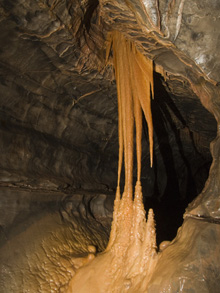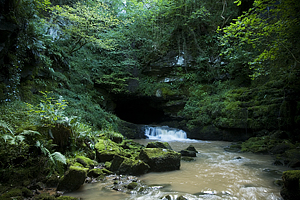 |
Cave Life of Wales |
 |
| |
| HOME |
| INTRODUCTION |
| LIFE IN THE ENTRANCE |
| LIFE IN THE CAVE |
| CONSERVATION |
| GLOSSARY |
| ACKNOWLEDGEMENTS |
| |
| Cave Climate |
| Adaptations |
Introduction |
||
The caves of Wales lie in limestone beds of the Carboniferous era which were deposited 359-328million years BP. The largest systems are in the band of limestone running west to east from near Llandeilo to Abergavenny and then arcing down past Pontypool, north of Cardiff and across Gower and South Pembrokeshire. In North Wales the limestone outcrops on Anglesey, through Clwyd and then south to Llanymynach. Caves include Britains deepest cave, Ogof Ffynnon Ddu (308m deep), the second longest cave, Ogof Draenen (c70km in length), and the largest passage, the Time Machine in Daren Cilau. Ogof Ffynnon Ddu (50km) was declared a National Nature Reserve in 1975 in recognition of its underground features and the surface karst. Many others are Sites of Special Scientific Interest (SSSI) such as the Minera caves, Otter Hole and Little Neath River cave.
The oldest caves of Wales date back to around 1 million years, and the earliest evidence of man are some Neanderthal remains discovered in Pontnewydd Cave, Denbighshire which are dated to around 230,000 years ago. Since then we have had numerous ice ages and our land connection with the continent has disappeared. During the last ice (ending around 10 000 years ago) much of the life in Wales was wiped out or moved to warmer climes (including our ancestors), and had to recolonise Wales as the ice retreated again. It is possible that some organisms survived the Ice Age by living deep underground where the temperature was above freezing, but food would have been a major difficulty. Organisms that survive underground for generations will often have adaptations to help them survive, and will lose some features that are of no benefit e.g. use of eyes. Those that are adapted to life underground become troglobites - cave dwellers that complete their life cycle in the cave and do not exist outside of this environment. These are the most fascinating creatures you will see underground, but they are also part of a delicate ecosystem that is easily disturbed by cavers and mans activities. The creatures found in caves can be classified according to how much of their life cycle they spend in the cave and how dependant they are on the cave environment. Troglophile: can successfully complete its life cycle both in and out of the cave environment. Troglobite: cannot complete life cycle outside of the cave environment. These have morphological adaptations to the cave environment e.g. blind, longer legs, lower metabolic rate. Cavernicole: a more general term for a creature that lives in a caves and can complete its life cycle there, but may also live in other dark habitats e.g. soil, under stones, bark. As many of our troglobites have only been underground since the last Ice Age they have not had time to evolve some of the bizarre adaptations seen abroad, where cave life has been unaffected by such catastrophes for much longer.
|

